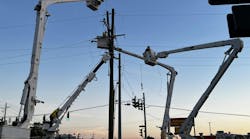Bill Meehan strongly believes in studying what makes us tick. Many do not live up to their potential because they never really understand what their natural advantages are, he maintains. “We tend to look for careers that we covet vs. do the things that come naturally to us.”
Meehan has done just that. He was good at math and liked to build things as a child. But he also had an artistic side. He played in a rock band and had a poem selected as his graduating class poem. He eventually combined his two talents to become an engineer, teacher and writer.
He has essentially had three separate full-time careers and one part time: Meehan worked for the power company for nearly 20 years, two engineering firms for 10 years and his current position working for a software company for 13 years.
Meehan is director, Utility Solutions, at Esri, a large GIS software company. His part-time career was teaching electrical engineering and computer applications at Northeastern University Graduate School of Engineering and University of Massachusetts. He has also had four books published, one of the most recent being GIS for Enhanced Electric Utility Performance. This book describes how geospatial technology in the form of a modern enterprise global information system (GIS) can help strengthen and improve all aspects of the electric utility business from Smart Grid, to generation, to transmission, to distribution, to the retail supply of electricity to customers. Whether your utility controls the entire supply chain of power delivery or has unbundled its delivery components, this book shows you how to bring the advantages of GIS technology to your entire operation.
“This book will show readers how to link technology to their work flows and to think differently about them – focus on the outcomes, not on the legacy processes,” Meehan said.
Meehan has also written Modeling Electric Distribution in GIS, Empowering Electric and Gas Utilities with GIS, and Power System Analysis by Digital Computer. He has also written a number of articles and given several presentations over the years.
Meehan’s teaching experience in universities had the biggest impact on his writing and presentations. Since he was teaching night programs, he had to figure out how to keep the students’ attention. He also had a pet peeve in college: Professors tended to work hard at making things seem complicated.
“I vowed that if I ever were to teach, I would try to use stories and examples to make the concepts easy,” Meehan said. “So I tried very hard to get at the heart of the material, rather than go over the real detail solutions. I would rather have a student understand the problem than get the exact right answers. They should also know whether the answers they got actually made sense rather than turning a crank to figure out the problem.”
Meehan said his presentations, books and blogs are not very technical, since they attempt to get at the heart of understanding (sometimes at the expense of rigor). In his presentations, he likes to challenge people to think differently about their work. In most industries, people get caught up in replicating the things that worked in the past. He tries to show how to break this cycle by introducing them to the notion of a “scatoma (tunnel vision). Innovation occurs when you complete challenge the status quo,” he said.
Meehan gets to do all the things he loves most at ESRI: Writing, speaking (performing really) and crafting the vision of GIS at utilities. “When I meet with utility customers, it’s like the old days teaching college – I love to create a deep understanding and appreciation of what the technology can do for them,” he said. “Since I have spent a great deal of my life running engineering and operations, I’ve seen how things work and how things can be improved.”
His love of GIS came about from a specific path. He interned at the local power company while in college and loved the industry. So he ended up majoring in electrical engineering. He then got a Master’s Degree in electric power systems. Working at an engineering firm, he became interested in automating work flows, particularly in the design of power plants. He built software to automatically design cable systems for plants. He also developed load flow, motor starting and short circuit analysis computer programs for power plants. He later found that the automated programs he developed applied to electrical distribution networks, which were mapped-based.
“So I became very interested in the application of mapping technology to utility networks – which if you are following this thread leads directly to Geographic Information Systems. I pioneered the use of GIS at the power company in the late 1980s. I have been hooked on GIS ever since,” Meehan said.


